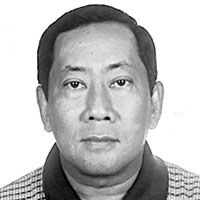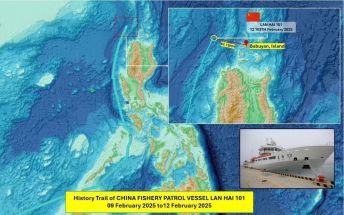We can build a high-teach navy for ourselves!

March 6, 2006 | 12:00am
For tonight' s Talkshow on Straight from the Sky, we give you an update of what the Ramon Aboitiz Foundation, Inc. (RAFI) has been doing in the past three years since we've had them on our show. We also discuss RAFI's Triennial Awards, which recognizes exemplary organizations or individuals who've one way or the other made a huge impact on the lives of those who thought things were hopeless until they came along.
To give us an insight of what RAFI is doing today, we have with us Mr. Roberto Aboitiz, Ms. Evelyn Nacario-Castro Executive Officer RAFI-EADSC and Ms. Mayette Rivera, chairwoman of the Triennial search committee. Also with us are two of RAFI's past awardees... judge Esperanza Garcia of the CFI Cooperative and Ms. Elena Limocon of Lamac MPC, who will be giving us their respective stories and how they have made an impact in their community.
Let me point out that we've had so many bad stories or news in the last few weeks... and telling the stories of organizations or individuals who gave so much to so many is something I love to do... hence this show tonight is merely a teaser of our future shows on the Triennial Awardees. So see them tonight in SkyCable's channel 15 at 8:00 p.m.
We were in Balamban last Saturday for the launching ceremony by FBMA Marine, Inc. (an Aboitiz Company) of Boat no. 1021, the world's 1st commercially produced high-tech Fastcraft vessel designed by Lockheed Martin, the world's largest defense contractor specializing in aeronautics and astronautics. For those old enough to remember, one of the best fighter aircraft during World War II was the Lockheed P-38, which can be easily distinguished by its twin boom and tail. The famous cargo plane, the C-130 Hercules which the Philippine Air Force still uses is made by Lockheed.
Lockheed apparently experimented with a Fastcraft design, which they called the "Sea Slice" because it slices even in rough seas and had it built in Hawaii in 1998. This design is called Small Waterplane Twin Hull (SWATH), which numerous countries have been experimenting.
The success of this Lockheed design gave the US Navy and Coastguard a very stable shooting platform for coastal defense. I saw this vessel in action in one of the programs of National Geographic's "Marine Machines" and it turned out that Lockheed agreed to a commercial application of this vessel and FBMA Marine launched the very first one. That's how high-tech Cebu has gone in the ship building industry!
When we got in the FBMA Marine yard, you couldn't miss seeing the high-tech design of the Sea Slice, because under its belly, you'd see four torpedo-like pontoons, that actually look like mini-subs, which when the vessel is put on the water you'd hardly notice them. It's been a known fact that submarines are not affected by rough waves because wave action happens only in the surface of the water. Hence this design allows the Sea Slice to run smoothly even in rough weather.
This particular vessel was designed by Lockheed Martin for the Mexican State Oil Company called Pemex and it will be operated by the Hoteleria y Servicios Petroleros in the Gulf of Mexico to bring back and forth workers in the oilrigs even through rough weather, in which helicopters cannot operate. In short, this vessel will replace the helicopter, as it is cheaper to run. This vessel took FBMA 12 months to build at a cost of US$ 9Million. It was named "Lider" (that's for Leader) by the Mexican executives, as it is the first of many they would be getting. A second one is already under construction also at the FBMA.
What's remarkable in this story is that, three nations cooperated in its design and manufacture... the United States for designing it for the Mexico's Pemex and the FBMA Marine, Inc. constructed it. Call it a joint cooperation program from the three nations that once had the Philippines under its wing. Yes, Mexico once used to run the Philippines for Spain, which is why we had the famous Galleon Trade.
Ernie Aboitiz, my favorite historian, told me that before the Galleon Trade, most of Europe got their exotic products from the famous Silk Route, which Marco Polo used bringing goods from China to Europe. But the Galleon Trade was more efficient in handling goods from point to point, unless a storm sunk the vessel. Bringing goods by land in those days was dangerous. But what we learned from last Saturday's launching was that, Cebuano hands with their expat managers like Mr. Doug Border are able to build the most sophisticated vessels. While the Lider is for commercial application... FMBA Marine has built on record 14 Fastcraft vessels for passenger like the TriCat that's used in Hongkong to Macau and an Air Crew boat for the British Navy. When will the Philippine Government realize that we can have our own Navy built right in our own backyard by Filipino hands so that we would finally have a Navy that floats?
For e-mail responses to this article, write to [email protected]
To give us an insight of what RAFI is doing today, we have with us Mr. Roberto Aboitiz, Ms. Evelyn Nacario-Castro Executive Officer RAFI-EADSC and Ms. Mayette Rivera, chairwoman of the Triennial search committee. Also with us are two of RAFI's past awardees... judge Esperanza Garcia of the CFI Cooperative and Ms. Elena Limocon of Lamac MPC, who will be giving us their respective stories and how they have made an impact in their community.
Let me point out that we've had so many bad stories or news in the last few weeks... and telling the stories of organizations or individuals who gave so much to so many is something I love to do... hence this show tonight is merely a teaser of our future shows on the Triennial Awardees. So see them tonight in SkyCable's channel 15 at 8:00 p.m.
Lockheed apparently experimented with a Fastcraft design, which they called the "Sea Slice" because it slices even in rough seas and had it built in Hawaii in 1998. This design is called Small Waterplane Twin Hull (SWATH), which numerous countries have been experimenting.
The success of this Lockheed design gave the US Navy and Coastguard a very stable shooting platform for coastal defense. I saw this vessel in action in one of the programs of National Geographic's "Marine Machines" and it turned out that Lockheed agreed to a commercial application of this vessel and FBMA Marine launched the very first one. That's how high-tech Cebu has gone in the ship building industry!
When we got in the FBMA Marine yard, you couldn't miss seeing the high-tech design of the Sea Slice, because under its belly, you'd see four torpedo-like pontoons, that actually look like mini-subs, which when the vessel is put on the water you'd hardly notice them. It's been a known fact that submarines are not affected by rough waves because wave action happens only in the surface of the water. Hence this design allows the Sea Slice to run smoothly even in rough weather.
This particular vessel was designed by Lockheed Martin for the Mexican State Oil Company called Pemex and it will be operated by the Hoteleria y Servicios Petroleros in the Gulf of Mexico to bring back and forth workers in the oilrigs even through rough weather, in which helicopters cannot operate. In short, this vessel will replace the helicopter, as it is cheaper to run. This vessel took FBMA 12 months to build at a cost of US$ 9Million. It was named "Lider" (that's for Leader) by the Mexican executives, as it is the first of many they would be getting. A second one is already under construction also at the FBMA.
What's remarkable in this story is that, three nations cooperated in its design and manufacture... the United States for designing it for the Mexico's Pemex and the FBMA Marine, Inc. constructed it. Call it a joint cooperation program from the three nations that once had the Philippines under its wing. Yes, Mexico once used to run the Philippines for Spain, which is why we had the famous Galleon Trade.
Ernie Aboitiz, my favorite historian, told me that before the Galleon Trade, most of Europe got their exotic products from the famous Silk Route, which Marco Polo used bringing goods from China to Europe. But the Galleon Trade was more efficient in handling goods from point to point, unless a storm sunk the vessel. Bringing goods by land in those days was dangerous. But what we learned from last Saturday's launching was that, Cebuano hands with their expat managers like Mr. Doug Border are able to build the most sophisticated vessels. While the Lider is for commercial application... FMBA Marine has built on record 14 Fastcraft vessels for passenger like the TriCat that's used in Hongkong to Macau and an Air Crew boat for the British Navy. When will the Philippine Government realize that we can have our own Navy built right in our own backyard by Filipino hands so that we would finally have a Navy that floats?
BrandSpace Articles
<
>
- Latest
- Trending
Trending
Latest
Trending

By BABE’S EYE VIEW FROM WASHINGTON D.C. | By Ambassador B. Romualdez | 1 day ago

By FIRST PERSON | By Alex Magno | 2 days ago
Latest
Recommended

February 13, 2025 - 11:09am





















